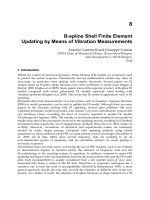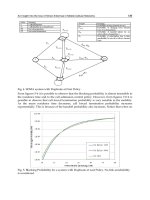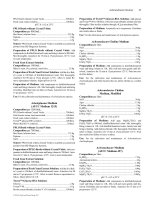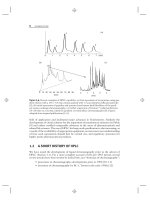Polyme Analysis 2010 Part 6 pps
Bạn đang xem bản rút gọn của tài liệu. Xem và tải ngay bản đầy đủ của tài liệu tại đây (232.47 KB, 9 trang )
Thermal Analysis
üThermal analysis (TA) is frequently used to describe analytical experimental
techniques which investigate the behaviourof a sample as a function of temperature.
TA refers to conventional TA techniques such as:
+Differential thermal analysis (DTA)
+Differential scanning calorimetry(DSC)
+Dynamic mechanical analysis (DMA)
+Thermogravimetry(TG/TGA)
Representative TA curves
The advantages of TA over other analytical methods can be summarized as follows:
(i)the sample can be studied over a wide temperature range using various temperature
programmes
(ii)almost any physical form of sample (solid, liquid or gel) can beaccommodated using
a variety of sample vessels or attachments
(iii)a small amount of sample (0.1 µg-10 mg) is required
(iv)the atmosphere in the vicinity of the sample can be standardized
(v)the time required to complete an experiment ranges from several minutes to several
hours
(vi)TA instruments are reasonably priced
Thermal Analysis
Scope:
üAs the sample goes through the programmed temperature change, there is no
temperature difference until the sample undergoes an exothermic or endothermic
chemical reaction or change of physical state.
üThe thermal event (a temperature difference between the sample and the
reference (∆T)) will be recorded→∆Tversus time or temperature plot
üMeasure the differential temperature between a sample and a reference pan
→ to determine the temperature of the transitions
Test procedures:
Differential thermal analysis (DTA)
Schematic of a DTA apparatus
Differential thermal analysis (DTA)
A DTA curve
The subscripts represent: s-sample, r-reference, i-initial,f-final.
T
r
Tg = Glass Transition Temperature = The temperature (°C) at which an amorphous
polymer or an amorphous part of a crystalline polymer goes from a hard, brittle state to
a soft, rubbery state.
Tm = melting point = The temperature (°C) at which a crystalline polymer melts.
∆Hm = the amount of energy in (joules/gram) a sample absorbs while melting.
Tc = crystallization point = is the temperature at which a polymercrystallizes upon
heating.
∆Hc = the amount of energy (joules/gram) a sample releases while crystallizing.
The data can be used to identify materials, differentiate homopolymersfrom
copolymers or to characterize materials for their thermal performance.
Differential Scanning Calorimeter(DSC)
Scope: DSC measures:
üA sample of 10 to 20 mg in an aluminum
sample pan is placed into the differential
scanning calorimeter.
üThe sample is heated at a controlled
rate (usually 10°/min)
üa plot of heat flow versus temperature
is produced.
üThe resulting thermogram is then
analyzed.
Test Procedure:
Dsc3.wmv
DSC









